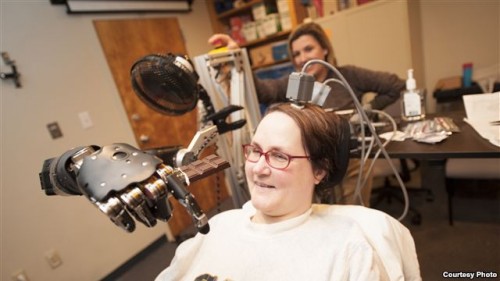
Recent breakthroughs in neuroengineering are making science fiction movies a reality. Just as Luke Skywalker from Star Wars uses his thoughts to move a synthetic arm, some patients are acquiring the ability to have their brains manipulate the movement of artificial arms after weeks of neuronal signal analysis and training.
A paragon of achievement in this area is a woman, paralyzed from the neck down, who was able to move an artificial arm with her brain. This motorized arm, called Hector, was designed by University of Pittsburg researchers led by the neurobiologist Andrew Schwartz. The team implanted 200 electrodes in the woman’s cerebral cortex to record the action potential, a momentary change in a cell’s electric potential, from individual neurons. By analyzing the codes, the research group was able to decipher the intention of the patient and develop a 13-week training program for her. The artificial limb has a processor that converts the neuronal signals to computer commands promoting movements. The patient, who had been suffering from a degenerative neuromuscular disease, managed to train her left cerebral cortex after just two weeks of practice to manipulate the intricately engineered prosthetic. Schwartz’s research group plans to develop another artificial arm for the patient to give her greater ability to manipulate objects and to grant her more natural hand movements. The group’s next ambitious objective is to eliminate the need for wires and the supervision of scientists by creating a wireless brain-machine interface.

A joint collaboration between the Johns Hopkins University Applied Physics Laboratory and Uniformed Services University of the Health Sciences has brought about another recent accomplishment that can substantially improve the life quality of patients suffering from paralysis. This group has built a nine-pound prosthetic arm that gives the user 22 degrees of freedom, which are measurements of independent movement of a rigid body in three-dimensional space. Most advanced robot arms typically have 14 degrees of freedom. Utilizing the idea that the nerves along the spinal cord still continue to function with some arm muscles, the research group has designed an arm that detects electronic signals from muscles and transforms them into computer codes that will guide the arm. These electronic signals originate in the brain and move along the spinal cord to reach the arm muscles and generate movement. Such an invention not only enables patients to regain their ability to move, but also aims to bolster their esteem, emotions, and sense of self.

The common hope shared by many scientific groups is to soon reach a higher level of prosthetic arms production. Shortening the training period in a virtual environment and extending the same technology to prosthetic legs are the next goals sought by many research groups. Palpability — the capacity to sense through touching — is another future goal involving a more sophisticated approach that would require two-way communication. Bioengineers have started developing such an interface with laboratory-grown nerve fibers and electricity-conducting polymers, and hope to devise better artificial arms within a few years.
